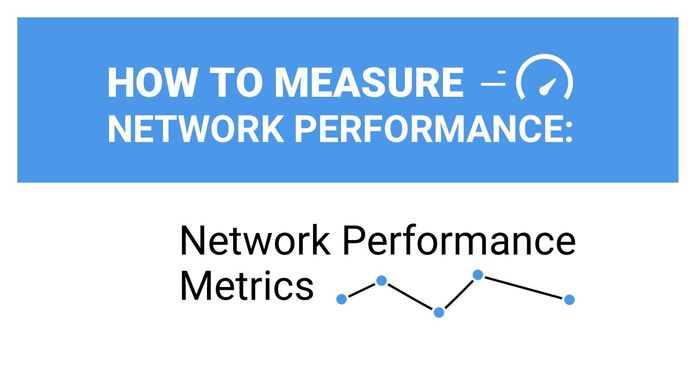Table of Contents
Table of Contents
In today's digital age, where fast and reliable connectivity is crucial for both personal and professional endeavours, understanding how to accurately measure network throughput has become an essential skill for network professionals and enthusiasts alike. Whether you're troubleshooting network performance issues, optimizing bandwidth allocation, or simply aiming to enhance your overall network efficiency, this guide will equip you with the knowledge and tools to measure network throughput like a seasoned network professional.
Get ready to dive into the realm of network performance measurement and unlock the secrets behind achieving lightning-fast data transfers. From the fundamentals to advanced techniques, we'll explore step-by-step procedures, practical tips, and essential tools that will empower you to become a master of network throughput measurement. So, let's embark on this exciting journey together and unravel the mysteries of network throughput like true network professionals!
Network throughput refers to the amount of data that can be transmitted through a network within a given period of time. It is a critical performance metric that measures the efficiency and capacity of a network infrastructure.
In simpler terms, network throughput quantifies the speed at which data can travel from one point to another across a network. It is influenced by factors such as bandwidth, latency, packet loss, and network congestion.


Throughput and bandwidth are closely related but represent different aspects of network performance:
Bandwidth: Theoretical Capacity: Think of bandwidth as the width of a highway. It’s the maximum data volume your network can handle at a given time, typically measured in bits per second (bps).
For example, if your network has a bandwidth of 100 Mbps, it means that theoretically, 100 megabits of data can flow through every second—assuming no obstacles.
Throughput: Actual Performance: Throughput, on the other hand, is the actual amount of data successfully transmitted over the network in a given timeframe. It’s like measuring how many cars actually make it through the highway in an hour.
Throughput can be lower than bandwidth due to factors like congestion, packet loss, latency, or device limitations.
Why Does It Matter?: Monitoring both bandwidth and throughput helps identify performance issues:
- If throughput is significantly lower than bandwidth, it indicates inefficiencies or bottlenecks.
- This distinction is crucial for optimizing network performance and ensuring applications run smoothly.
Network throughput is a measure of the rate at which data can be transmitted across a network. It quantifies the amount of data that can be transferred per unit of time. Network throughput is commonly expressed in bits per second (bps) or in higher units of measurement such as kilobits per second (Kbps), megabits per second (Mbps), or gigabits per second (Gbps).
When measuring network throughput, the unit of measurement indicates the number of bits transmitted or received within a one-second time frame. Here's a breakdown of the common units:
- Bits per second (bps): This is the fundamental unit of measurement for network throughput. It represents the number of individual bits transmitted or received in a second. For example, if your network has a throughput of 1 Mbps, it means that one million bits can be transferred per second.
- Kilobits per second (Kbps): One kilobit is equivalent to 1,000 bits. Kbps is often used to express lower-speed network connections or data transfer rates. For instance, an internet connection speed of 256 Kbps means that 256,000 bits can be transmitted or received per second.
- Megabits per second (Mbps): One megabit is equal to 1,000 kilobits or 1,000,000 bits. Mbps is a common unit for measuring network throughput for home broadband connections or local area networks (LANs). For example, a network with a throughput of 100 Mbps can transfer 100 million bits in one second.
- Gigabits per second (Gbps): One gigabit equals 1,000 megabits or 1,000,000,000 bits. Gbps is typically used to measure high-speed network connections, such as enterprise-level networks or internet backbone infrastructure. For instance, a network with a throughput of 10 Gbps can transfer 10 billion bits per second.

Imagine a highway with four lanes, designed to handle a high volume of traffic. If three lanes are closed for repairs, all the cars are forced into a single lane, drastically reducing how many vehicles can pass through at once. Even though the highway is theoretically capable of handling four lanes of traffic, its actual capacity is now limited to that one open lane.
Similarly, your network might have a theoretical bandwidth of 100 Mbps, but due to issues like congestion or packet loss, only a portion of that capacity—say 25%—is being used effectively. This means your actual throughput is limited to 25 Mbps.

If your throughput falls short of what you expect, it’s a sign that something may be wrong. Ask yourself:
- Is there congestion? Data traffic jams can slow things down.
- Are packets getting lost? Dropped packets mean some data isn’t reaching its destination.
- Are there other issues? Performance problems like jitter or high latency could be at play.
Here, a network and throughput monitoring tool acts like a traffic control system for your highway. It identifies where and when traffic jams occur, helping you pinpoint issues and optimize your network to achieve maximum throughput.
Let's get into that!
There are many techniques and tools on the market to help you measure network throughput, but they can’t all give you the complete view of your network performance that you truly need. There are so many factors that can affect network throughput and impact network performance - so you need a tool that can monitor them all.
Network Monitoring Tools (or Network Performance Monitoring) are the most accurate and detailed method for measuring network throughput and end-to-end network performance. These tools monitor network traffic, data packets, and metrics, allowing you to observe network throughput patterns, identify bottlenecks, and gain insights into the overall network performance. Many also have their own Network Throughput Monitoring tool embedded in them.
What are you waiting for? Let’s get into the deployment!
Looking for an easy tool to help you monitor network performance and measure network throughput? Enter Obkio’s Network Performance Monitoring tool.
Obkio's Network Performance Monitoring tool is a synthetic, end-to-end solution that allows you to measure, analyze, and optimize your network throughput like never before.
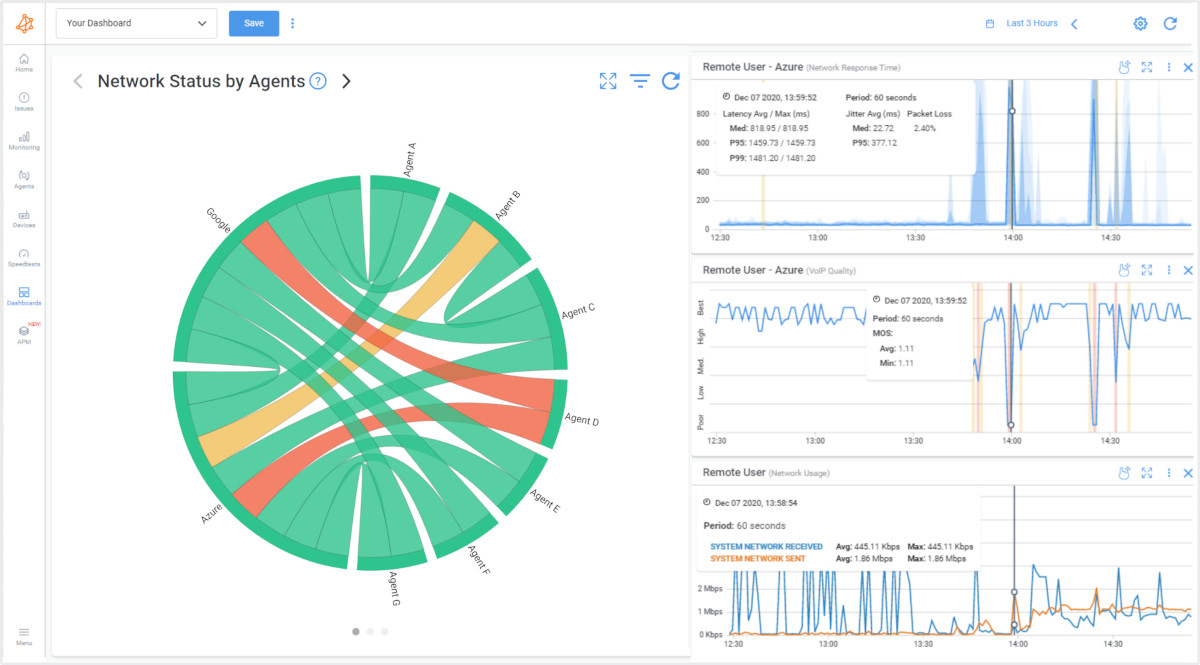
Obkio measures network throughput and other key network metrics using synthetic traffic to simulate real-world network behaviour and end-user experience. Obkio’s Network Agents are deployed at different ends of your network and continuously exchange synthetic traffic to measure performance. With synthetic testing, Obkio can accurately measure throughput without the effect of external factors, or any impact on user experience.

Obkio measures network throughput using continuous synthetic traffic from Network Monitoring Agents deployed in key network locations like offices, data centers and clouds.
For your end-to-end monitoring setup, you’ll need the following Monitoring Agents (which Obkio’s Onboarding Wizard with help you deploy):
- Local Agents: Installed in the targeted office location where you want to measure network throughput and network performance. There are several Agent types available (all with the same features), and they can be installed on MacOS, Windows, Linux and more.
- Public Monitoring Agent: These are deployed over the Internet and managed by Obkio. They compare performance up to the Internet and quickly identify if the problem is global or specific to the destination. For example, measure network throughput between your branch office and Google Cloud.
The Agents measure throughput in your network by sending and monitoring synthetic traffic through your network every 500ms using for the most precise network throughput measurements.
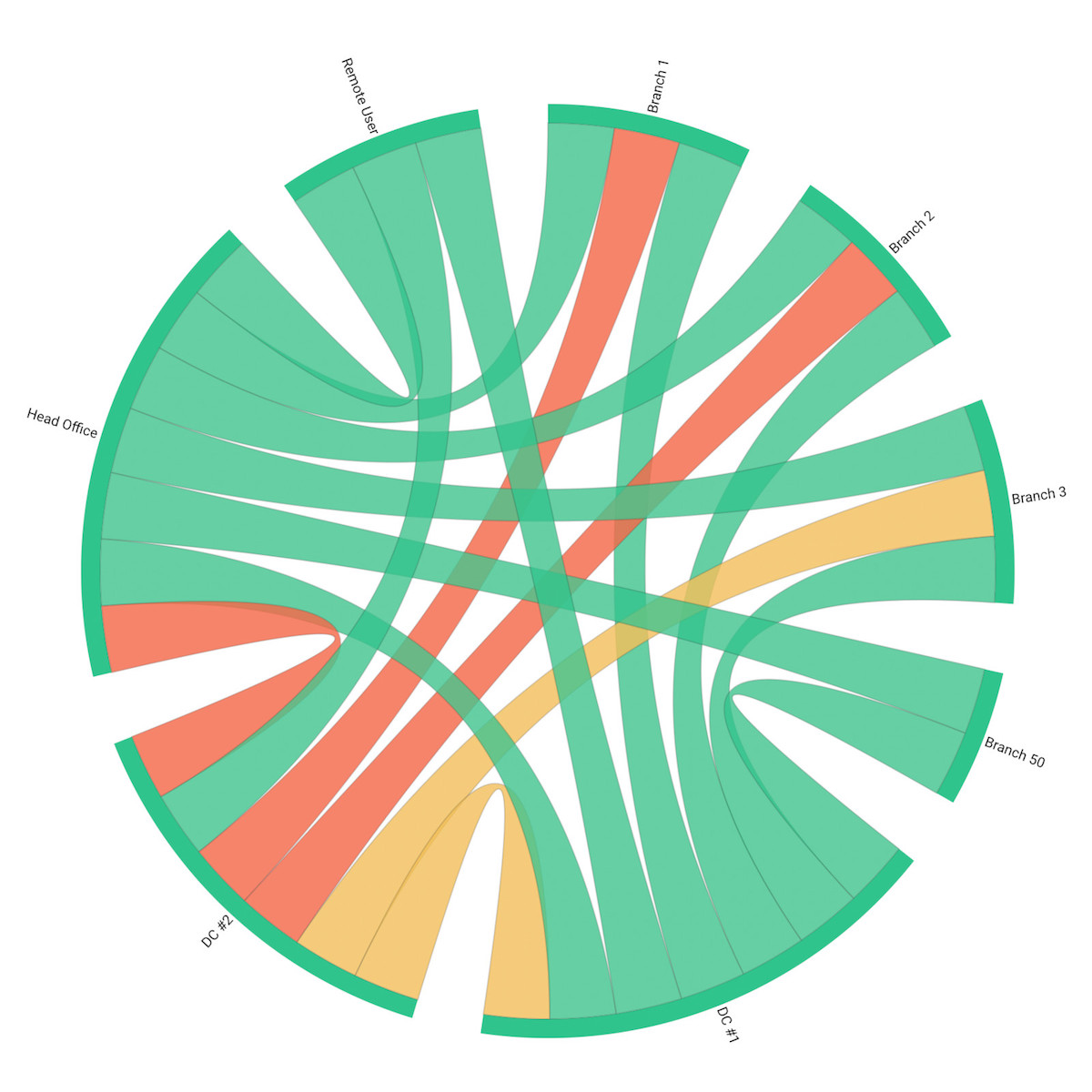
Obkio measures network throughput using advanced synthetic monitoring and real-time capabilities designed to provide accurate and insightful network performance data. That’s because Obkio isn’t just a one-time performance testing tool - it’s a complete network performance wizard!
By measuring key network metrics like network throughput, Obkio can quickly identify and help you troubleshoot network issues affecting your network performance.
Here's an overview of how Obkio measures network throughput in more detail:
- Round-Trip Time (RTT) Calculation: Obkio measures the Round-Trip Time (RTT) for each data packet sent between endpoints. RTT is the time it takes for a packet to travel from the source to the destination and back. By measuring the RTT, Obkio can determine the latency and network response time of the network, which indirectly affects the throughput calculation.
- Packet Loss Detection: Obkio's monitoring system tracks the presence of packet loss during the data transmission process. It identifies any dropped packets and measures the rate of packet loss, which can impact throughput. By measuring packet loss, Obkio can provide insights into network quality and reliability.
- Bandwidth Utilization: Obkio examines the amount of bandwidth used during data transmission. By monitoring the volume of data transferred over time, it can calculate the average and peak bandwidth utilization. This information is essential for understanding how effectively the available bandwidth is being utilized and its impact on overall throughput.
Utilizing these techniques, Obkio enables network administrators and IT professionals to obtain precise measurements of network throughput, equipping them with the ability to monitor, analyze, and optimize their network performance effectively.
By employing these methods, you gain the capability to assess your network throughput rates and evaluate whether they meet your expectations or fall below the anticipated thresholds. This analysis allows you to make informed decisions and take appropriate actions to enhance your network's efficiency and performance.
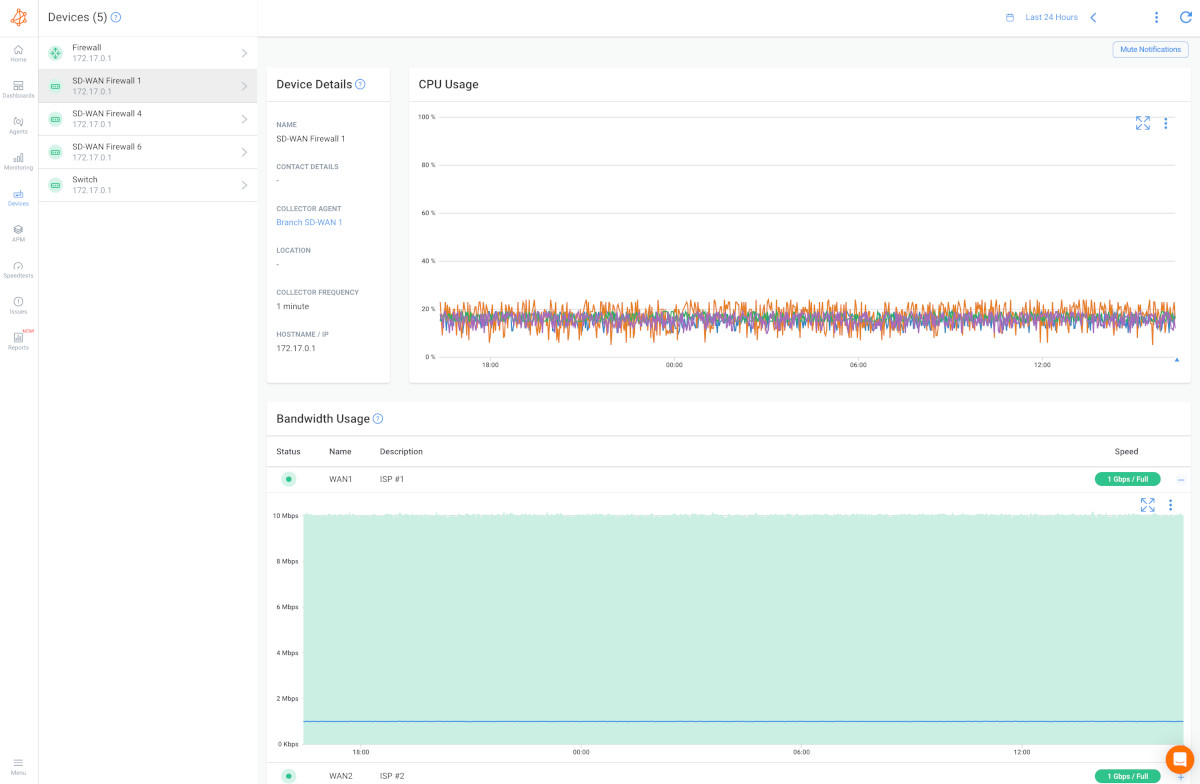

When it comes to measuring network throughput and understanding your Internet connection's speed, nothing beats a Speed Test. It provides an instant snapshot of your current connection speed by sending a significant amount of data across your network and tracking the time it takes to reach its destination.
But why stop at a one-time test? With a comprehensive network performance monitoring solution like Obkio, you can take your speed tests to the next level. Obkio enables you to manually run or schedule speed tests between monitoring Agents or groups of Agents. This ensures that your network speed or throughput is constantly monitored, giving you real-time insights into performance.
What sets Obkio apart is its ability to perform speed tests with multiple TCPs simultaneously. This multi-threaded approach ensures the most accurate and reliable speed test results. No more guesswork or relying on single-threaded tests that may not reflect your actual network capabilities.
So, whether you want to assess your network's speed in the moment or maintain continuous monitoring, Obkio has you covered. Visit Obkio's website to explore their Speed Test capabilities and unlock the full potential of your network speed.
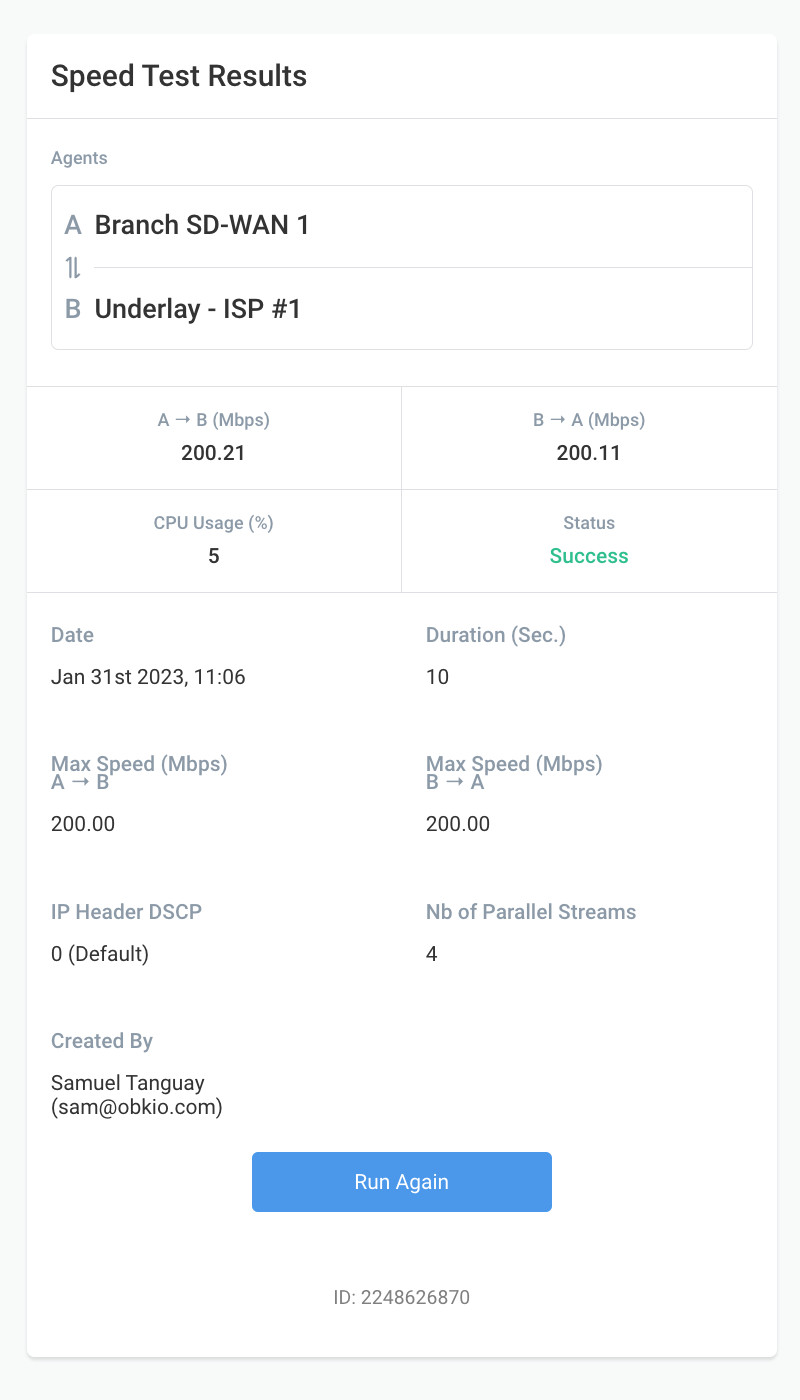
Obkio's monitoring platform goes above and beyond mere network data collection, providing you with robust analysis and reporting functionalities that enable you to delve deep into your network throughput and gain valuable insights.
With Obkio, you have the power to go beyond surface-level information and dive into a comprehensive analysis of your network throughput. The platform equips you with the tools to generate detailed reports, enabling you to extract meaningful insights and make informed decisions regarding your network's performance.
Obkio's monitoring tool generates comprehensive reports that prioritize network throughput and other essential network metrics. These detailed reports offer a wealth of information, including average and peak throughput values, trends observed over time, and insightful comparisons between various Monitoring Agents or network segments. With their clear and concise format, these reports provide a comprehensive overview of your network's throughput performance.
Through Obkio's analysis and reporting features, you gain the ability to precisely identify performance bottlenecks that might impede network throughput. By thoroughly analyzing the collected data, you can pinpoint network segments, devices, or specific configurations that are responsible for reduced throughput. Armed with this valuable knowledge, you can take focused actions to optimize those areas and enhance the overall performance of your network.
Real-time and historical measurements are essential when measuring network throughput. They provide valuable insights into network performance and enable IT professionals to make informed decisions for optimization. Real-time measurements offer immediate visibility into network activities, allowing prompt issue detection and resolution. On the other hand, historical measurements provide a broader perspective, aiding in trend analysis and long-term optimization strategies.
Together, they create a powerful toolset for proactive management and fine-tuning network performance. In this section, we explore how Obkio leverages real-time and historical measurements to accurately measure network throughput, troubleshoot issues, and optimize network infrastructure.
Obkio offers real-time monitoring of network throughput, allowing you to track changes and fluctuations as they occur. With live data feeds and intuitive network visualizations, you can keep a finger on the pulse of your network and quickly identify any performance issues that may impact throughput. Real-time monitoring enables proactive troubleshooting and optimization.
Obkio's monitoring tool stores historical data on network throughput, enabling you to analyze trends and patterns over time. By reviewing historical performance, you can identify long-term changes in throughput, seasonal variations, or recurring bottlenecks. This information helps you make informed decisions for network planning, capacity management, and optimization strategies.
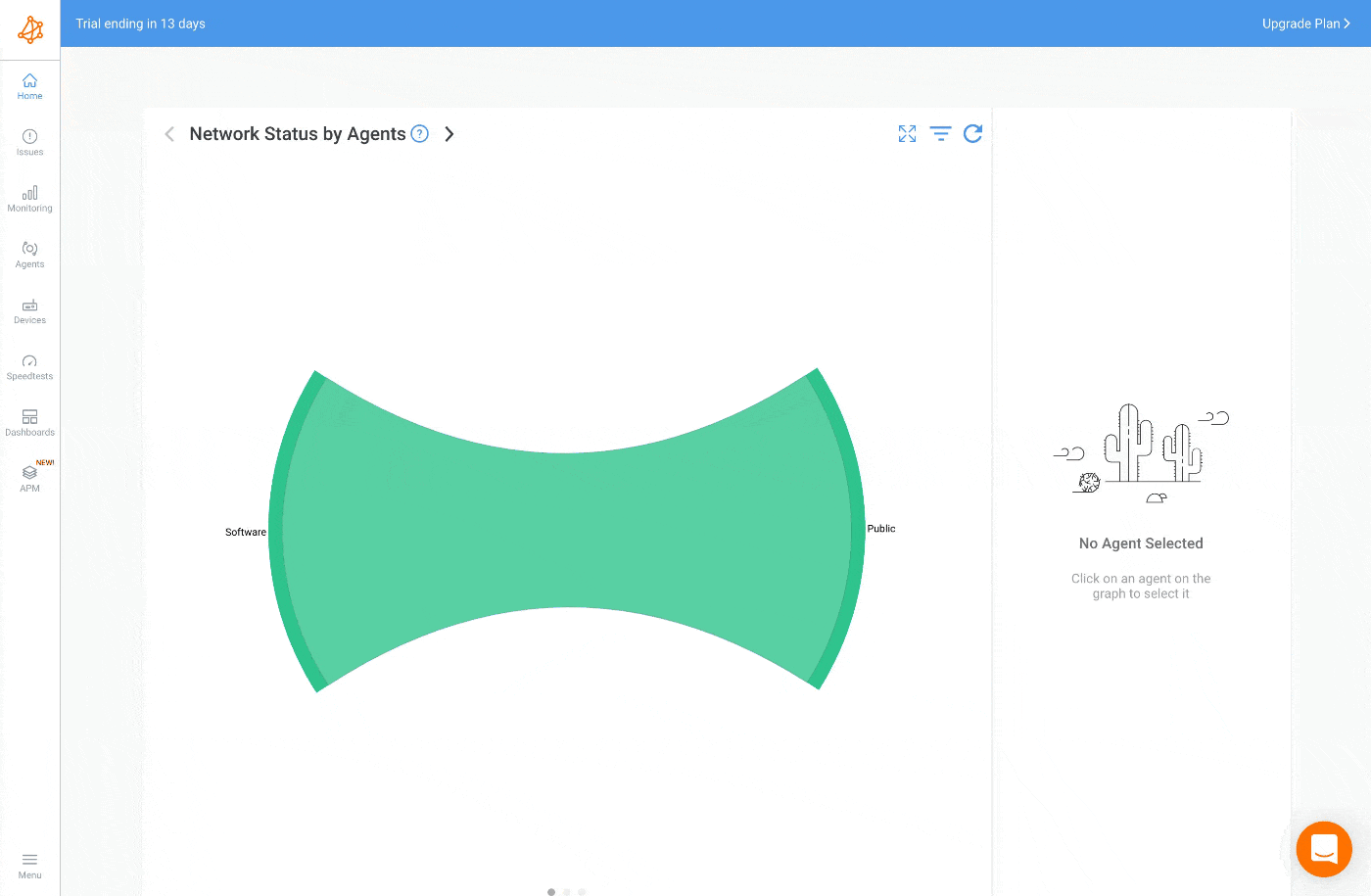
With this network monitoring setup, you now have everything you need to continuously monitor network performance and measure network throughput in all your network locations. You can now easily identify if your network throughput is not meeting your expectations, or if there are any network issues affecting throughput in your network.
If there are, Obkio will provide you with the information you need to know what the issue is, when it happened, where, and why.
Several network issues can affect network throughput and impact the overall performance of a network. Here are some common network issues that can hinder network throughput:
- Network Congestion: Network congestion occurs when there is an excessive demand for network resources, leading to decreased throughput. Congestion can be caused by factors such as heavy network traffic, inadequate network capacity, or inefficient network design. It can significantly impact network performance and result in slower data transfer rates.
- Bandwidth Limitations: Network throughput can be limited by the available bandwidth. Bandwidth limitations can occur due to network infrastructure constraints, service provider limitations, or intentional bandwidth restrictions. Insufficient bandwidth can lead to reduced throughput and slower data transfer speeds.
- Network Latency: Latency refers to the delay or lag experienced when transmitting data packets across a network. High latency can negatively impact throughput as it increases the time taken for data to travel between the sender and receiver. Latency issues can be caused by factors such as long network distances, network congestion, or inefficient routing.
- Packet Loss: Packet loss happens when data packets fail to reach their destination. It can occur due to network errors, congestion, or issues with network devices. Packet loss can result in reduced throughput and retransmissions, leading to slower data transfer rates.
- Network Jitter: Network jitter refers to the variation in delay between received data packets. It can cause inconsistent network performance and affect throughput by introducing unpredictability in the timing of data transmission. Jitter is commonly observed in networks with varying network conditions or inadequate Quality of Service (QoS) mechanisms.
- Network Hardware Issues: Faulty or misconfigured network hardware, such as routers, switches, or network interface cards, can lead to degraded network throughput. Issues like outdated firmware, hardware failures, or incorrect configurations can impact data transmission rates and overall network performance.
- Security Measures: Network security measures, such as firewalls or intrusion detection systems, can introduce additional processing overhead and impact network throughput. While security measures are essential for protecting the network, improperly configured or overloaded security devices can lead to reduced throughput.
Learn how to detect network congestion & perform a network congestion test inside & outside your network with Network Monitoring & Network Device Monitoring.
Learn more

So how do you actually collect network throughput measurements? You can’t do it manually - but network throughput can be measured using various techniques, each providing valuable insights into the performance of a network.
Here are some commonly used methods:
Network monitoring tools, such as SNMP (Simple Network Management Protocol) network monitoring tools or commercial network monitoring software, can track network utilization and provide real-time or historical information on network throughput. Tools, like Obkio’s Network Monitoring tool, gather data from network devices and calculate throughput based on the traffic passing through them.
The steps we explained above show you how to measure network throughput using this technique.


Synthetic monitoring, which is also known as active monitoring or proactive monitoring is a network performance monitoring technique used to monitor application and network performance by simulating user activity with network resources to test network performance, detect issues and measure network metrics. Synthetic monitoring features are sometimes integrated with tools like Obkio.
The steps we explained above show you how to measure network throughput using Obkio’s Synthetic Network Monitoring tool.
Bandwidth testing is a commonly used technique for measuring network throughput. It involves sending a known amount of data across a network connection and measuring the time it takes for the transfer to complete.
To calculate the network throughput, the data size is divided by the time taken. This division yields the rate at which the data was transmitted over the network connection. The result is often expressed in bits per second (bps), kilobits per second (Kbps), megabits per second (Mbps), or gigabits per second (Gbps), depending on the scale of the network's capacity.
This technique provides a direct measurement of the network's capacity and speed, allowing administrators to assess performance, identify bottlenecks, and optimize network resources. Various tools are available for conducting bandwidth tests, enabling accurate measurement and analysis of network throughput.
Learn about the differences between network speed, bandwidth & throughput. Find out why your business should measure them and how!
Learn more

This method involves capturing and analyzing network packets to determine throughput. By examining the packet headers and timestamps, network administrators can calculate the number of packets transferred within a specific time frame. Dividing this packet count by the time duration provides the packet transfer rate, which represents the throughput of the network.
Certain applications, such as file transfer protocols (e.g., FTP, SCP) or network performance testing tools, offer built-in features to measure network throughput. These tools simulate data transfers and provide network statistics on the transfer rate, giving a direct measurement of network throughput.
Load testing involves simulating high traffic volumes to evaluate network performance under heavy load conditions. By generating artificial traffic, load testing tools measure network throughput by monitoring how well the network handles the increased load.
These tools are designed specifically for measuring network throughput. These tools can help you to measure the actual speed of your network, by simulating a data transfer between two points on the network.
Your operating system may have built-in command-line tools that you can use to measure network throughput.
On Windows, one commonly used command-line tool is "netstat." By running the "netstat" command with appropriate parameters, users can view a range of statistics related to network traffic. This includes information such as the number of bytes sent and received, as well as the current connection status. Analyzing these statistics over a period of time can provide insights into network throughput and performance.
Linux users can leverage command-line tools such as "ifconfig" and "netstat" to measure network throughput. The "ifconfig" command provides details about network interfaces, including transmission and reception rates. By monitoring the data transferred through specific network interfaces and analyzing the rates, users can estimate network throughput. Additionally, the "netstat" command on Linux offers similar functionality as on Windows, providing information about active network connections and associated statistics.
There are many websites that offer online network speed test tools. These tests typically measure the download and upload speeds of your network, which can give you an indication of your network throughput. Examples of popular online speed tests include Speedtest.net, Fast.com, and TestMy.net.
The OSI model is a conceptual framework that describes how data is transmitted over a network and should be considered when you’re looking to monitor network throughput. It consists of seven layers, each of which plays a specific role in the transmission of data.
There are different methods to measure network throughput at each different layer of the OSI model. Let’s go through each:
- Physical layer: The physical layer is responsible for transmitting bits over a physical medium. To measure network throughput at this layer, you can use tools such as oscilloscopes, signal generators, and multimeters to measure signal strength, noise, and other physical characteristics of the network.
- Data link layer: The data link layer is responsible for the reliable transmission of data over a physical link. To measure network throughput at this layer, you can use tools such as network analyzers and protocol analyzers to capture and analyze data packets, including error rates, frame size, and frame transmission time.
- Network layer: The network layer is responsible for routing data between networks. To measure network throughput at this layer, you can use tools such as network analyzers to capture and analyze IP packets, including routing information, packet size, and packet transmission time.
- Transport layer: The transport layer is responsible for providing reliable end-to-end delivery of data. To measure network throughput at this layer, you can use tools such as network analyzers and transport layer protocols, such as TCP or UDP, to capture and analyze data transmission rates, congestion, and other factors.
- Session layer: The session layer is responsible for establishing, maintaining, and terminating sessions between applications. To measure network throughput at this layer, you can use tools such as network analyzers and session layer protocols, such as SSH or Telnet, to capture and analyze session establishment and termination times, as well as data transfer rates.
- Presentation layer: The presentation layer is responsible for data formatting and presentation. To measure network throughput at this layer, you can use tools such as network analyzers to capture and analyze data formats and encoding, including data compression and encryption.
- Application layer: The application layer is responsible for providing network services to end-users. To measure network throughput at this layer, you can use tools such as network analyzers and application protocols, such as HTTP or FTP, to capture and analyze application-level data transfer rates, response times, and other factors.
Note that the methods used to measure network throughput at each layer may vary depending on the specific protocol, tool, or technique used. It's also important to keep in mind that network throughput is influenced by a variety of factors, such as network topology, traffic volume, and the number of users, and that measuring throughput at each layer is just one part of the overall network performance analysis.


When measuring network throughput, several factors can influence the results, and it's crucial to take them into consideration for accurate assessment.
Here are some key factors to keep in mind:
Network congestion occurs when there is excessive demand for network resources, leading to a decrease in throughput. During peak usage periods, such as when many users are accessing the network simultaneously, congestion can impact the measured throughput. It's important to be aware of potential congestion issues and consider conducting tests during different usage scenarios to obtain a more comprehensive understanding of network performance.
Network throughput can be limited by the available bandwidth. Bandwidth constraints can arise due to the network infrastructure, service provider limitations, or intentional traffic shaping. Understanding the maximum bandwidth capacity of the network connection is essential to contextualize the measured throughput. It's beneficial to compare the measured throughput against the known maximum bandwidth to assess how efficiently the network is utilizing the available capacity.
The number of users sharing the network connection can impact the measured throughput. In multi-user environments, increased network activity from other users can lead to decreased available bandwidth and lower throughput. Considering the number of users and their activities during the measurement is essential for accurate analysis.
To obtain a more accurate picture of network performance, running multiple tests at different times is recommended. By conducting tests during various periods, you can capture the network's behaviour under different load conditions. This approach helps identify potential fluctuations in throughput and provides a more comprehensive understanding of how the network performs in different scenarios.
Luckily, Obkio continuously measures network throughput for you so you don’t have to! With synthetic traffic being exchanged every 500ms, Obkio measures network throughput network performance with updates by the minute.
By considering these factors and conducting tests at different times, you can obtain a more accurate and reliable assessment of your network's performance. This information allows you to make informed decisions, identify areas for improvement, and optimize your network to achieve the desired throughput levels.
Learn how to measure network performance with key network metrics like throughput, latency, packet loss, jitter, packet reordering and more!
Learn more

Interpreting network throughput measurements is a crucial step in understanding the performance and efficiency of your network. Once you’ve measured your network throughput, you need to understand what you’re looking for. If you’re using a tool like Obkio, it’ll do the work for you - letting you know when your network throughput rates are less than ideal, and when network issues are present.
But, by analyzing the obtained metrics, you can still gain valuable insights into the data transfer rate and identify potential areas for improvement. Here are some key aspects to consider when interpreting network throughput measurements:
Network throughput measurements are typically expressed in bits per second (bps), kilobits per second (Kbps), megabits per second (Mbps), or gigabits per second (Gbps). Understanding the metric and unit used is essential for proper interpretation and comparison with network capacity or service level agreements (SLAs). It is also important for SLA monitoring.
It's important to distinguish between average and peak throughput values. Average throughput represents the typical data transfer rate over a given period, providing a baseline for network performance.
Peak throughput, on the other hand, represents the maximum achieved data transfer rate, indicating the network's highest capacity. Analyzing both average and peak throughput values provides a comprehensive view of network performance.
Tracking throughput measurements over time allows you to identify trends and patterns. By analyzing historical data, you can observe how throughput fluctuates under different conditions, such as peak network usage hours or specific activities. This insight can help you plan network resources, anticipate future demands, and identify potential performance issues.
Comparing measured network throughput against expected or desired values is crucial for evaluating network performance. If the measured throughput consistently falls below expectations, it may indicate issues such as network congestion, bandwidth limitations, or hardware limitations. Conversely, if the measured throughput consistently meets or exceeds expectations, it suggests a healthy network performance.
Network throughput measurements should be correlated with other relevant network metrics to gain a holistic understanding of network performance. Factors such as latency, packet loss, or jitter can impact throughput. Analyzing these metrics in conjunction with throughput measurements can help pinpoint the root cause of performance issues and guide troubleshooting efforts.
Network throughput measurements should be interpreted within the context of the specific network environment. Factors such as network topology, hardware configurations, or network policies can influence throughput. Understanding the unique characteristics of your network and how they may affect throughput helps in accurately interpreting the measurements.
Benchmarking your network throughput against industry standards or service level agreements (SLAs) provides a benchmark for performance evaluation. Comparing your network's throughput measurements with these benchmarks helps determine if the network is meeting expected standards or if improvements are needed.
Learn about SLA monitoring & reporting using Network Monitoring to measure network, service performance, user experience & understand if SLAs are being met.
Learn more

By considering these factors and applying a thoughtful analysis, you can extract meaningful insights from network throughput measurements. This knowledge enables you to make informed decisions, optimize network performance, and ensure that your network meets the desired requirements and expectations.
Businesses, regardless of their size or industry, should measure network throughput for several important reasons. While measuring network throughput is commonly associated with Internet Service Providers (ISPs), it is equally relevant and beneficial for businesses. Here's why:
- Performance Optimization: Measuring network throughput allows businesses to assess the performance of their internal networks. By monitoring and analyzing throughput data, businesses can identify and address bottlenecks, congestion, or other issues that impact network performance. This optimization leads to improved efficiency, faster data transfer, and enhanced productivity for employees.
- User Experience: Businesses rely on network connectivity to access critical applications, collaborate with colleagues, and serve customers. Network throughput directly affects user experience. By measuring and optimizing network throughput, businesses can ensure smooth and reliable connectivity, reducing delays, interruptions, and frustration for employees and customers.
- Application Performance: Many businesses rely on bandwidth-intensive applications such as video conferencing, cloud-based services, and data-intensive processes. Measuring network throughput helps businesses gauge whether their network can handle the demands of these applications. By optimizing throughput, businesses can ensure that applications run smoothly, reducing latency and maintaining a high level of performance.
- Resource Allocation: Measuring network throughput assists businesses in determining appropriate resource allocation. By understanding network capacity and throughput, businesses can allocate bandwidth resources effectively, ensuring critical applications receive the necessary bandwidth while avoiding over-provisioning or underutilization of network resources.
- Security and Threat Detection: Network throughput measurements can aid in identifying potential security threats. Unusual drops in throughput may indicate a network intrusion or malware activity. Monitoring throughput allows businesses to detect anomalies, respond promptly, and implement necessary security measures to protect sensitive data and systems.
- Cost Optimization: By measuring network throughput, businesses can gain insights into their bandwidth utilization and requirements. This information helps optimize bandwidth provisioning, ensuring that businesses are not paying for excessive bandwidth that goes unused or facing performance issues due to insufficient bandwidth.
- SLA Compliance: Many businesses rely on network service providers to deliver a certain level of network performance as per service level agreements (SLAs). Measuring network throughput allows businesses to monitor whether the provided network service meets the agreed-upon performance standards, enabling them to hold service providers accountable and ensure compliance.
- Capacity Planning: Measuring network throughput helps businesses plan for future growth and expansion. By understanding current network capacity and throughput, businesses can anticipate future demands, scale their network infrastructure accordingly, and ensure that the network can support increased workloads and user requirements.
In summary, businesses should measure network throughput to optimize performance, enhance user experience, ensure application performance, allocate resources effectively, detect security threats, optimize costs, comply with SLAs, and plan for future growth. Network throughput measurement is a valuable tool for businesses to maintain a reliable and efficient network infrastructure, enabling them to operate at their best and meet the demands of a connected world.


So we now know why it’s important for businesses to measure network throughput, let’s look at some examples. Real-world examples and case studies provide practical insights into how network throughput measurements are applied and the impact they have on various scenarios.
These real-world examples highlight the practical application of network throughput measurements in diverse scenarios. By conducting measurements, organizations can identify performance bottlenecks, optimize network infrastructure, and enhance the overall network experience for users.
In each case study, network throughput measurements played a vital role in diagnosing issues, making informed decisions, and implementing effective solutions. By leveraging the insights gained from these measurements, organizations were able to optimize their network performance, enhance user satisfaction, and improve their overall business operations.
An enterprise with multiple office locations experiences inconsistent network performance across different branches. By measuring network throughput with Obkio’s Network Monitoring tool and analyzing historical trends, they identify specific branches with consistently lower throughput.
Further investigation reveals outdated network equipment and suboptimal configurations as the cause. They upgrade their network infrastructure, implement Quality of Service (QoS) policies, and optimize network settings to improve throughput and enhance overall connectivity.
An e-commerce company notices a decline in website performance during peak shopping periods, resulting in slow page load times and dissatisfied customers. By measuring network throughput during these peak periods, they identify network congestion as the root cause.
With this information, they optimize their network infrastructure, upgrade bandwidth capacity, and implement traffic management strategies to ensure smooth performance during high-demand periods.
A video streaming service aims to deliver high-quality video content to its users without buffering or interruptions. By deploying Obkio’s Network Monitoring tool in all network locations and conducting network throughput measurements in different regions and on different devices, they identify areas with insufficient bandwidth or high latency.
Armed with this data, they strategically place content delivery servers in those regions, optimizing network routing to minimize latency and deliver an enhanced streaming experience.
A company adopts cloud-based applications to support its business operations. However, they notice sluggish performance and intermittent connectivity issues. By measuring network throughput between their on-premises network and the cloud service provider, using Obkio’s Network Monitoring Agents deployed in each network location, they identify network bottlenecks and latency.
With this insight, they reconfigure their network settings, optimize routing, and employ dedicated network connections to the cloud provider, resulting in improved application performance and a seamless user experience.
So you’re measuring your network throughput, and realize that you’re not getting the throughput rate you were promised by your ISP - so what now?
Troubleshooting network throughput issues is a critical task for businesses to ensure optimal network performance. When faced with slow data transfer rates or subpar throughput, businesses need to identify and address the underlying issues promptly. Once you know what the problem is, you can then troubleshoot internally, or reach out to your ISP.
To give you a hand with this process, here are key steps to effectively troubleshoot network throughput issues using a Network Monitoring tool, like Obkio:
Start by observing and documenting the symptoms of the throughput issue. This may include slow file transfers, buffering during media streaming, or latency in application response times. Gathering specific information about the symptoms helps in narrowing down the potential causes.
Use network monitoring tools, like Obkio, to monitor and analyze network performance. This allows you to identify any congestion points (WAN or LAN congestion), abnormal traffic patterns, or excessive bandwidth utilization that may be impacting throughput. By monitoring performance metrics such as latency, packet loss, and jitter, you can pinpoint specific issues affecting network throughput and take appropriate actions for optimization.
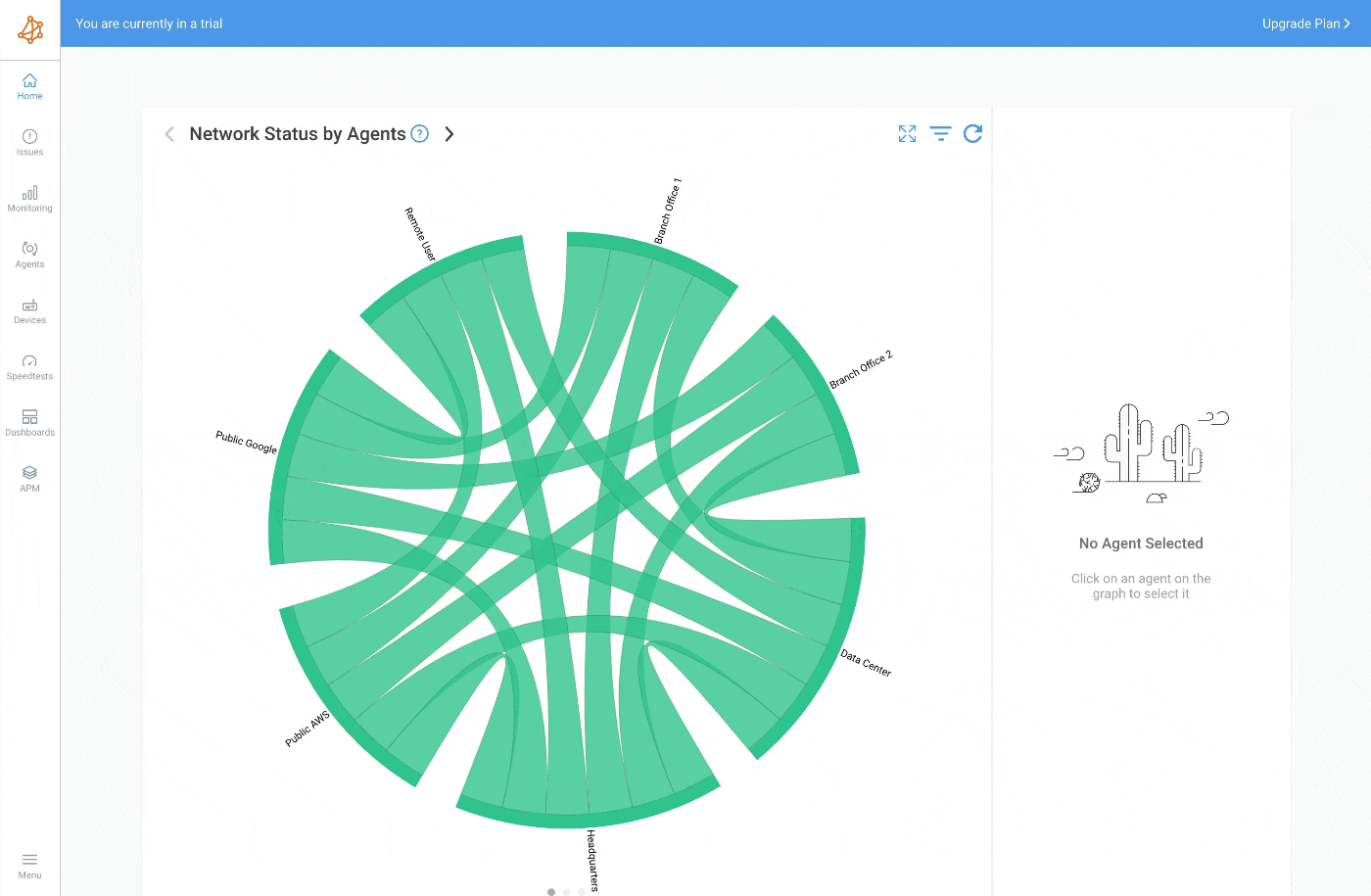

Check for basic factors that may affect throughput, such as network cable connections, hardware issues, or misconfigured network settings. Verify that all network devices are functioning properly and connections are stable.
Review your network infrastructure, including routers, switches, and access points, to ensure they can handle the required bandwidth and network load. Check for any firmware updates, misconfigurations, or hardware limitations that may impact throughput. You can do these using Obkio’s Network Device Monitoring feature.
QoS settings can prioritize certain types of network traffic, potentially affecting throughput for other applications. Review your QoS policies and configurations to ensure that they are appropriately optimized for the desired network performance. Obkio’s Network Monitoring tool also has a QoS Monitoring feature to help you out with that!
Evaluate whether the available bandwidth is sufficient for your network requirements. When monitoring your network performance you may discover bandwidth limitations on your network devices, either from your service provider or internal network infrastructure. If that’s the case, consider upgrading your bandwidth capacity if it is insufficient for your needs.
Latency issues, such as high round-trip times or delays, which can negatively affect throughput. Analyze and measure latency using Obkio’s Network Monitoring tool to identify potential latency sources, such as network bottlenecks or routing inefficiencies. You’ll receive automatic notifications if your latency levels are higher than your set thresholds.
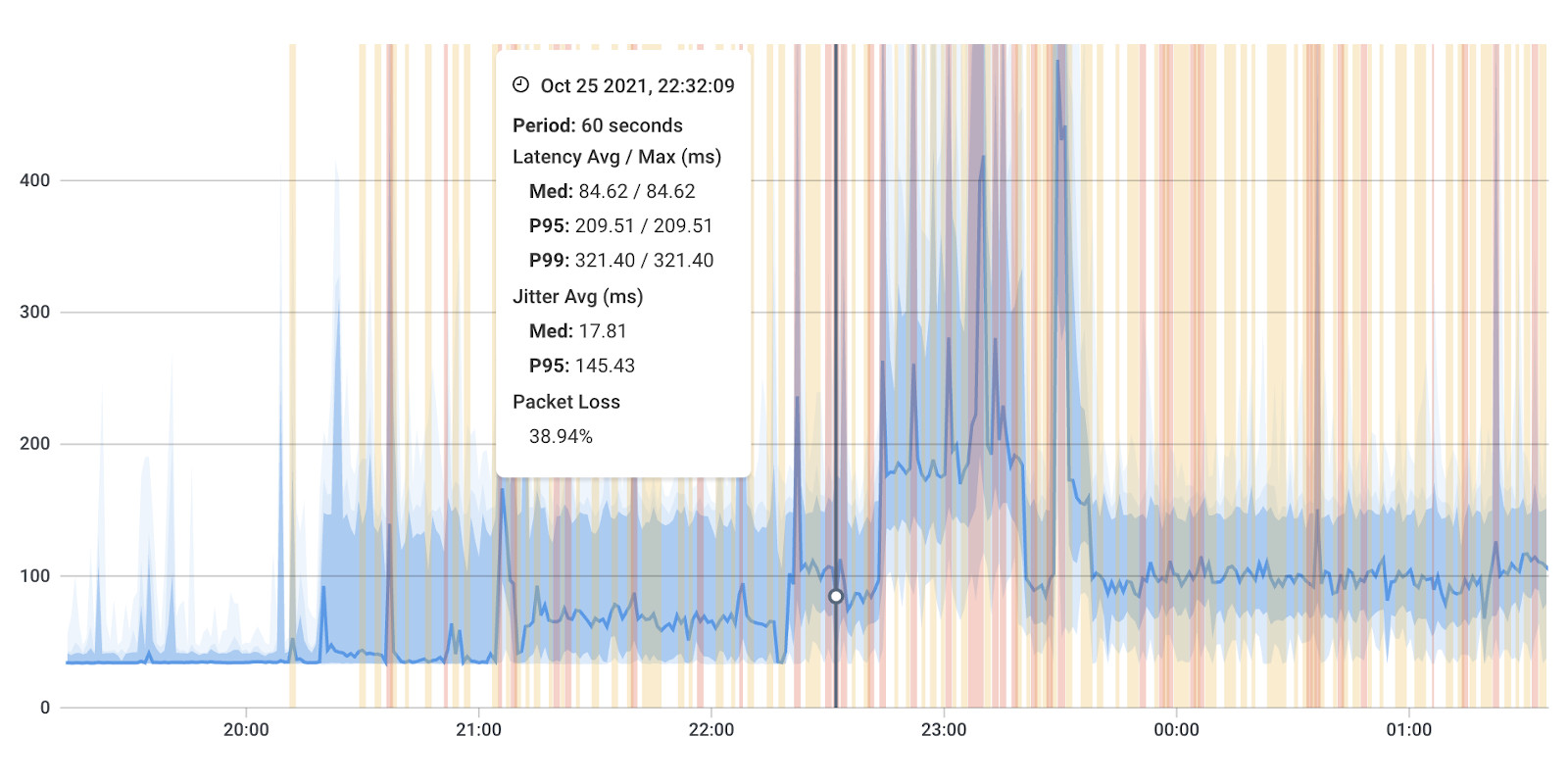
If the issue persists and involves the network service provider, engage with them to troubleshoot and diagnose potential external factors affecting throughput. They can provide insights into network congestion, network overload, infrastructure issues, or service-level problems.
Use Obkio's Visual Traceroutes to determine if the issue is specific to a particular location on the internet or if it's on your service provider's side. This information can then be used to open a service ticket with your service provider and provide them with as much data as possible to aid in their troubleshooting and resolution of the issue.
Based on the troubleshooting steps and identified issues, if the network throughput issue is happening in your local network, you need to troubleshoot and implement an appropriate fix internally. This may involve:
- Adjusting Network Configurations: After identifying specific configuration issues impacting throughput, make necessary adjustments to network settings. This may involve modifying routing tables, adjusting firewall rules, or optimizing network protocols. By fine-tuning network configurations, businesses can eliminate bottlenecks and improve data transfer rates.
- Upgrading Hardware: Outdated or inadequate network hardware can limit throughput. If the investigation reveals that hardware limitations are causing the issue, consider upgrading networking equipment such as routers, switches, or network interface cards (NICs). Upgrading to higher-capacity or more efficient hardware can significantly enhance network throughput.
- Optimizing Quality of Service (QoS) Settings: Configuring QoS settings appropriately can prioritize critical network traffic, ensuring better throughput for essential applications. Evaluate and optimize QoS policies, (such as QoS for VoIP) to allocate network resources effectively. By assigning appropriate priorities and bandwidth limits to different types of traffic, businesses can optimize throughput for mission-critical applications.
- Reducing Network Congestion: If network congestion is identified as the root cause, take measures to alleviate it. This may involve load-balancing traffic across multiple links, implementing traffic shaping techniques, or deploying content delivery networks (CDNs) to offload network congestion. By effectively managing and distributing network traffic, businesses can improve throughput in congested areas.
- Upgrading Bandwidth Capacity: If network throughput consistently falls below desired levels due to insufficient bandwidth, consider upgrading the network's capacity. Upgrading to higher bandwidth connections or adding additional bandwidth channels can enhance throughput and accommodate growing network demands.
- Implementing Network Optimization Techniques: Explore network optimization techniques such as traffic compression, caching, or protocol optimization. These techniques can minimize data overhead, reduce latency, and improve overall network efficiency, resulting in enhanced throughput.
After implementing your fix, closely monitor the network throughput to validate if the issues have been resolved. Additionally, you’ll want to keep your Network Monitoring tool as a permanent fixture to continuously monitor network performance to detect any recurring or new throughput issues and take necessary actions promptly.
Review network performance metrics, conduct periodic assessments, and perform maintenance activities to proactively identify any emerging issues and fine-tune network configurations as needed.
Before we let you on your way to measure and assess your network throughput, we wanted to leave you with some best practices to ensure accurate and reliable network throughput measurements!
- Define Clear Objectives: Clearly define the objectives of your network throughput measurement. Determine what specific aspects you want to evaluate, such as overall network performance, application-specific performance, or the impact of network changes. Having clear objectives helps focus the measurement process and ensures that the collected data aligns with your goals.
- Select Appropriate Tools: Choose reliable and suitable tools for measuring network throughput. Consider factors such as compatibility with your network environment, the level of accuracy required, and the specific metrics or data you need to capture. Depending on your needs, you may use bandwidth testing tools, packet capture tools, or network monitoring software. Of course, we recommend Obkio’s simplest and easy Network Monitoring tool!
- Establish Baseline Measurements: Before making any changes to your network infrastructure or configurations, establish baseline measurements of network throughput. Your Network Monitoring tool will help with this! This provides a reference point for future comparisons and helps you assess the effectiveness of any optimization efforts. Network baselines also aid in detecting performance deviations and potential issues.
- Test Different Time Periods: Perform throughput measurements during various time periods to account for fluctuating network conditions. Networks often experience different traffic patterns during peak and off-peak hours. Testing during different periods provides a more comprehensive understanding of network performance and helps identify potential bottlenecks during high-demand periods. Once again, with a tool like Obkio that continuously monitors network performance, you won’t need to set this up manually.
- Multiple Test Points: Conduct measurements from multiple test points within your network using Obkio’s Monitoring Agents. This includes measuring throughput between different network segments, across different devices, or between different locations if applicable. Multiple test points provide a broader view of network performance, identifying potential issues specific to certain segments or devices.
- Perform Comparative Analysis: Compare throughput measurements against relevant benchmarks, service level agreements (SLAs), or industry standards. Comparative analysis helps assess the network's performance in relation to established norms, ensuring compliance and identifying areas for improvement.
- Long-term Trend Analysis: Analyze historical throughput data over an extended period to identify trends and patterns. Long-term trend analysis helps identify seasonality, network capacity planning needs, or performance degradation over time. It enables proactive optimization and facilitates informed decision-making.
- Regular Monitoring and Maintenance: Network throughput measurement should be an ongoing process. Continuously monitor network performance, regularly update measurement procedures, and adapt to changing network conditions. Regular maintenance ensures that network throughput remains optimized and aligned with evolving business requirements.
Following these best practices helps organizations achieve accurate and meaningful network throughput measurements. By adhering to these guidelines, businesses can make informed decisions, optimize network performance, and ensure a reliable and efficient network infrastructure.


Mastering the art of measuring network throughput is a valuable skill for any network professional and you're now equipped with the skills of a network pro when it comes to measuring network throughput! With the techniques, troubleshooting tips, and network monitoring best practices we've covered in this blog post, you're ready to optimize your network like a boss and ensure a smooth sailing experience.
But wait, there's more! To supercharge your network monitoring game, it's time to bring in the big guns: Obkio’s Network Monitoring tool! With its arsenal of advanced features, real-time monitoring, and historical data reporting, Obkio is your trusty sidekick in continuously measuring network throughput.

No more guesswork or mundane monitoring routines. Embrace the power of Obkio and unleash your inner network hero!
- 14-day free trial of all premium features
- Deploy in just 10 minutes
- Monitor performance in all key network locations
- Measure real-time network metrics
- Identify and troubleshoot live network problems



























 Obkio Blog
Obkio Blog






